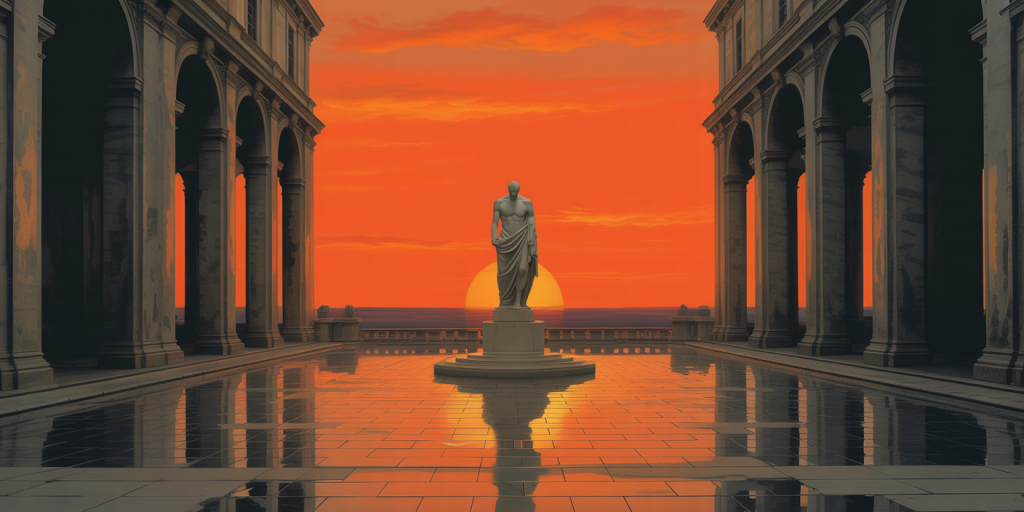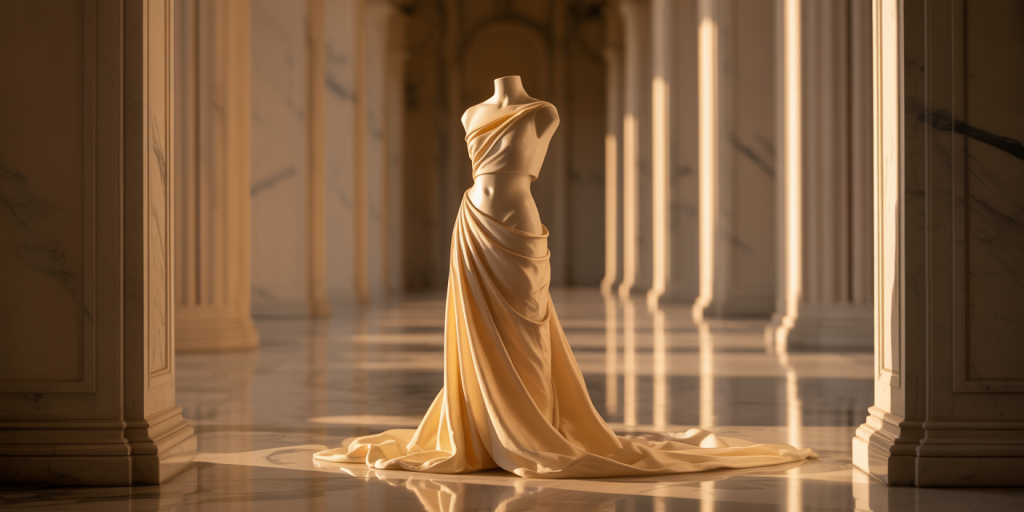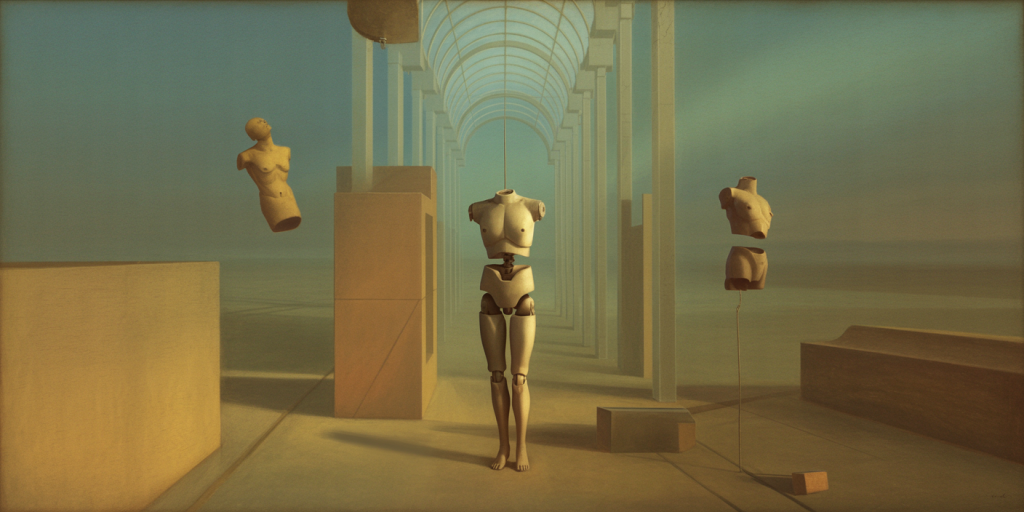From Concrete to Emptiness: Walking with Giorgio de Chirico at Dusk
Opening Meditation
There is a moment in the late afternoon when light turns to gold but casts no warmth. It stretches across stone plazas and vacant arcades like a hush made visible. In this eerie hush, Giorgio de Chirico’s world begins—not with presence, but with estrangement. The air thickens with metaphysical silence, and the streets echo not with footsteps, but with absence.
“From Concrete to Emptiness” is not a journey through space but through sensation. We walk not to arrive, but to drift. The buildings lean into stillness, statues glance sideways at shadows, and the light, that golden, unmoving light, seems to question the nature of time itself. De Chirico paints not the seen, but the remembered; not life, but its afterimage. In his landscapes, everything stands—and nothing breathes.

Table of Contents
- The Stillness Behind the Arch
- Statues That Do Not Sleep
- Elongated Shadows of Forgotten Hours
- Trains That Whisper in the Distance
- The Echoes of Empty Colonnades
- The Orange Sky of Psychological Tension
- Mannequins in the Place of Men
- Geometry as Emotional Architecture
- Towers, Windows, and Watchers
- The Sound of Marble Dust
- Glances Frozen in Perspective
- Desolate Arcades and the Philosophy of Space
- Silence Draped in Fabric
- The Clock Without a Time
- The Horse that Stands, the Rider Who’s Gone
- The City that Refuses to Wake
- Dusk as a Permanent Threshold
- The Cold Poetry of Distance
- Between Vision and Vertigo
- Walking Toward the Unnameable
The Stillness Behind the Arch
In De Chirico’s compositions, arches do not merely frame—they arrest. Their curvature is less an architectural element than a metaphysical gateway. What lies beyond is not a place, but a question. Often, a statue stands alone behind the arch, and the viewer is drawn toward it—not to observe, but to wonder why it does not move.
Light here is sharp and linear, slicing through space with precision, but illuminating nothing warm. The textures are smooth, unblemished—suggesting a world untouched by decay, and yet irreparably detached. The arch does not invite; it delays.
Statues That Do Not Sleep
The figures in De Chirico’s world are not alive, nor convincingly inanimate. They inhabit a third state—one of symbolic dormancy. Their marble eyes see nothing, yet seem to witness everything that no longer is. They are votive ghosts, memorials to an emotion just missed.
Often headless or draped, they resist individuality. Their identity is archetypal. Their meaning lies in their placement—in the plaza, under the colonnade, facing a void. These statues are the punctuation of metaphysical syntax: silences, pauses, ellipses in stone.
Elongated Shadows of Forgotten Hours
Time in De Chirico’s paintings does not tick. It stretches. Shadows fall at impossible angles, defying sun and logic. They are theatrical exaggerations, more about feeling than physics. They lengthen across the canvas like visual sighs.
The elongated shadow becomes a second presence. It often points to nothing or away from the presumed light source. It is memory’s shadow more than matter’s. Through these distortions, De Chirico unearths the anxiety beneath stillness.
Trains That Whisper in the Distance
A motif that recurs in De Chirico’s work is the tiny, distant train—smoking quietly along a horizon it never seems to cross. It is as though the industrial world has been muted, reduced to suggestion.
This train, so far away, carries not passengers but connotations: departure, nostalgia, irreversibility. It is the movement one can no longer catch. And so it becomes symbolic—not of future, but of detachment from the present.
The Echoes of Empty Colonnades
Colonnades recur, echoing endlessly. They draw the viewer’s gaze inward, only to terminate in abrupt solitude. No crowd moves within them, no voice echoes from the stone.
The rhythm of column after column creates a visual incantation. It becomes a prayer for meaning in a space built precisely to disallow certainty. Within these corridors, the soul wanders but never exits.
The Orange Sky of Psychological Tension
De Chirico’s skies are not natural. They are symbolic. The most haunting is that saturated orange—sunset’s final protest. It feels less like a backdrop and more like a psychological event.
The juxtaposition of warm skies with cold architecture creates a tension that vibrates invisibly. This dissonance becomes emotional texture: you can feel it in your chest, like a memory returning too vividly.
Mannequins in the Place of Men
Often replacing human figures are mannequins—jointless, featureless, and yet charged with emotional suggestion. They are not uncanny in the modern sense; they are deliberately unwhole.
These mannequins are not characters. They are ideas in posture form. When placed together, they do not interact. They pose beside one another like unresolved questions, echoing themes of isolation, artifice, and the unspoken.
Geometry as Emotional Architecture
There is a rigor in De Chirico’s spatial constructions. Triangles of roof, circles of arches, rectangles of light: all meticulously placed. Yet their perfection unsettles.
This geometry becomes a kind of emotional infrastructure. The eye is led predictably—and then left suspended. Nothing leads where it should. The viewer is thus forced into contemplation rather than orientation.
Towers, Windows, and Watchers
Towers populate the backgrounds like silent sentinels. Their windows are black, unlit, impenetrable. Someone—or something—might be watching, but never revealed.
These towers are less places of habitation than of anticipation. They do not rise; they loom. The psychological effect is one of delay—of meaning just out of reach, or judgment silently withheld.
The Sound of Marble Dust
Though visual, De Chirico’s works evoke sound. Not of cities, but of absence: the muted scrape of stone, the breath of an empty plaza, the distant shudder of unseen movement.
His brushwork accentuates this silence. The clean edges, the matte surfaces—all feel as though dust has settled on perception itself. We don’t hear life; we hear the void that follows it.
Glances Frozen in Perspective
Perspective in De Chirico’s world is both masterful and malevolent. It guides us precisely to where we do not want to arrive. Every vanishing point conceals more than it reveals.
The viewer becomes the observed. We glance in—and the composition glances back, unblinking. It is not confrontation, but entrapment in awareness.
Desolate Arcades and the Philosophy of Space
The arcade is central to De Chirico’s metaphysics. It is shelter and exposure, echo and void. Its repetition suggests security, but delivers only echo.
Within arcades, space becomes philosophical. We do not move through it—we meditate within it. Its emptiness is not vacancy, but proposition.

Silence Draped in Fabric
Drapery, in many of his figures and forms, conceals rather than reveals. The folds of fabric are heavy with implication. What lies beneath is not hidden—it is negated.
The fabric becomes a metaphor for the ineffable. It does not whisper secrets, but guards them. Its texture is thick with mystery, its flow paradoxically static.
The Clock Without a Time
When clocks appear in De Chirico’s paintings, their hands often miss. Or they point to nonsensical hours. These clocks do not measure—they mock. They turn time into illusion.
Thus, time becomes psychological. The viewer is freed and trapped simultaneously—freed from chronology, trapped in eternity.
The Horse that Stands, the Rider Who’s Gone
A lonely horse may stand, unsaddled, alert but unmoving. The absence of the rider becomes louder than any presence. Who rode here? Why did they leave? When?
The horse becomes a monument to transition. It holds stillness like a votive flame. Its form is elegant, its gaze inscrutable.
The City that Refuses to Wake
No day begins in De Chirico’s cities. No window lights, no footfall stirs. Morning is withheld. Night has not arrived. It is always entardecer: that in-between moment where light lingers but life does not.
This perpetual dusk suspends narrative. The world exists, but does not unfold. It is a city sculpted for silence.
Dusk as a Permanent Threshold
Twilight, for De Chirico, is not an hour—it is a condition. The entire canvas seems filtered through that golden-brown pause between sun and dark.
This threshold is not passage, but permanence. We are not crossing over. We are dwelling in-between. It is the space where introspection crystallizes.
The Cold Poetry of Distance
Distance is a character in De Chirico’s work. Not measured in meters, but in emotions. Objects are near and unreachable. Figures are present and unknowable.
This emotional distancing creates a cold poetics. The viewer is both participant and exile. The heart strains forward—but the canvas does not yield.
Between Vision and Vertigo
Looking at a De Chirico is not passive. It’s a teetering act—between recognition and disorientation. The linear logic of his lines invites, then unsettles.
Vertigo sets in not because the world turns, but because it stands too still. Vision becomes weight. Thought becomes texture.
Walking Toward the Unnameable
To walk in De Chirico’s landscapes is not to go forward. It is to approach an idea that cannot be spoken. His cities do not end—they evaporate.
And so we walk—not through geography, but through a metaphysical atmosphere. Toward what? Toward something the canvas cannot explain, only suggest.
FAQ – Questions and Answers
Who was Giorgio de Chirico?
An Italian painter born in 1888, De Chirico is known for founding the Metaphysical Art movement, influencing Surrealism. His early works are famed for their haunting plazas, classical motifs, and philosophical themes.
What defines his metaphysical style?
Stillness, dramatic light and shadow, classical architecture, enigmatic figures, and spatial ambiguity define his unique aesthetic—a mix of dream and architecture.
Why do his paintings feel “silent”?
De Chirico deliberately eliminates motion and crowding, placing objects and figures in spatial limbo to evoke a psychological stillness that transcends language.
What influenced his symbolism?
Philosophy, especially Nietzsche and Schopenhauer, mythology, Renaissance art, and personal nostalgia informed his metaphysical vocabulary.
How did his work impact future artists?
He was a key precursor to Surrealism. Artists like Magritte, Dali, and Max Ernst cited De Chirico as foundational to their dreamlike imagery and symbolic architecture.
Epilogue – A Plaza That Waits Forever
De Chirico does not invite us into his world. He abandons us inside it. We do not leave his plazas—we become their shadows. The statues we pass are not watching us; they are us, returned to stone.
From concrete to emptiness, we do not traverse space—we traverse meaning. We walk endlessly, at dusk, accompanied by silence. And somewhere in that golden haze, truth withdraws just beyond the reach of form.

